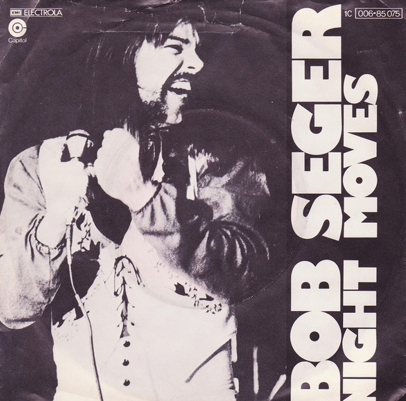It’s Wednesday and I hope this week has been kind to you thus far. Time to take a closer look at another song I’ve only mentioned in passing or not covered at all. My pick is Night Moves by Bob Seger.
Night Moves, written by Seger, is the title track of his nineth studio album that came out in October 1976, the first to credit the Silver Bullet Band. The song also became the album’s first single. Both helped transform Seger from a regionally prominent music artist to a national star.
The single became Seger’s highest-charting in the U.S. at the time, climbing to no. 4 on the Billboard Hot 100. Up north in Canada, it reached no. 5. Elsewhere, it peaked at no. 25 in Australia and no. 45 in the UK. The album got to no. 8 on the Billboard 200 and reached no. 13 in Australia. It became one of Seger’s best-selling, reaching Gold certification in the U.S. (500,000 certified sold units) in just three months and, as of September 2003, 6xPlatinum (6 million units). In Canada, it was certified Triple Platinum (300,000 units) as of October 1979.
Night Moves is a largely autobiographical song inspired by a young woman Seger met when he was 19 and fell in love with. But she had a boyfriend who was away in the military, and when he returned she married him, leaving Seger heart-broken. While as such it wasn’t a happy ending in the romantic department, I guess it’s a consolidation it provided lyrical content for Seger’s breakthrough single. Here’s a great version from the Nine Tonight live album released in September 1981.
Songfacts notes Night Moves became the last song recorded for the album. It came together at Nimbus Nine Studios in Toronto, were Seger’s manager had booked three days with Canadian producer Jack Richardson. He brought in local guitarist Joe Miquelon and organist Doug Riley for the recording who joined Seger and Silver Bullet Band members Chris Campbell (bass) and Charlie Allen Martin (drums). Backing vocals were provided by Laurel Ward, Rhonda Silver and Sharon Dee Williams, a trio from Montreal.
Even though it’s a great song, Night Moves has not had many covers, which Songfacts attributes to the personal nature of the lyrics. They note Garth Brooks and The Killers have performed it live. Checking out SecondHandSongs revealed 17 covers, including the following cool version by Dolly Parton and Chris Stapleton, included on her most recent album Rockstar released in November 2023, a collaborative collection of mostly rock-oriented covers Parton recorded following her 2022 induction into the Rock and Roll Hall of Fame.
Following are select additional insights from Songfacts:
The phrase “night moves” has a number of meanings, which made it an intriguing song title. It could mean “putting the moves on” a girl in the back seat of a car, but Seger says it also relates to the impromptu parties he and his buddies threw in the fields of Ann Arbor, Michigan, where they would turn on the headlights and dance their “night moves.” They called these gatherings “grassers.”
Seger was inspired by the movie American Graffiti, which was released in 1973 but set in 1962. He said, “I came out of the theater thinking, Hey, I’ve a story to tell too. Nobody has ever told about how it was to grow up in my neck of the woods.”
The famous bridge in this song, where Seger strips it down and sings “I woke last night to the sound of thunder,” is something he and producer Jack Richardson came up with on the fly in the studio.
Seger wrote this song over a period of about six months. Along with “Turn The Page,” this was one of just two songs Seger ever wrote on the road.
This reflective track was a change of pace for Seger, whose songs tended to be rockers with lot of live energy. It wasn’t his first slower song though: “Turn The Page” was released in 1972 but got little attention. After “Night Moves” and the next single, “Mainstreet,” took off, many radio stations added “Turn The Page” to their playlists.
Like many of Seger’s songs, there is a touch of nostalgia in the lyrics. When he sings, “And it was summertime, sweet summertime, summertime,” he’s not only referring to the time of the year, but to that season of his life as well. In the last verse of the song, when he is reminiscing, he says, “With autumn closing in” and is referring to the autumn of his life, getting older.
The tempo changes were inspired by Bruce Springsteen’s “Jungleland.” Seger wrote the song in pieces; he had the first two verses written but was having trouble finishing the song. After hearing “Jungleland,” he realized he could connect the song with two distinct bridges.
“Night Moves” didn’t get a video when it was first released (it was five years before MTV), but when Seger’s Greatest Hits album was released in 1994, a video was made to promote it. The video borrows heavily from American Graffiti, showing young people at a ’60s drive-in, intercut with shots of Seger singing the song in the projection room.
According to Seger, he and the girl really made it in the backseat of a ’62 Chevy, but it didn’t fit lyrically, so he changed the line to “my ’60 Chevy.”
Seger revealed in a radio interview that in the line, “Started humming a song from 1962,” the song he had in mind was “Be My Baby” by the Ronettes (which was actually released in 1963).
Seger credits the Kris Kristofferson-written song “Me And Bobby McGee” for inspiring the narrative songwriting style he employed on this track.
Sources: Wikipedia; Songfacts; YouTube
